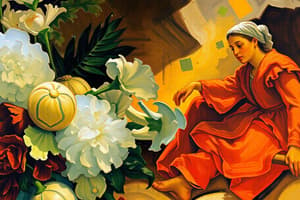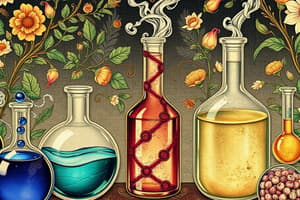Podcast
Questions and Answers
Which characteristic is NOT associated with a homogeneous mixture?
Which characteristic is NOT associated with a homogeneous mixture?
- Presence of distinct layers (correct)
- Solute dissolving in solvent
- Uniform composition throughout
- Complete mixing of components
A heterogeneous mixture has a uniform composition throughout.
A heterogeneous mixture has a uniform composition throughout.
False (B)
What is a homogeneous mixture also commonly called?
What is a homogeneous mixture also commonly called?
solution
In a solution, the substance present in the smaller quantity is called the ______.
In a solution, the substance present in the smaller quantity is called the ______.
Match each mixture type with its particle behavior:
Match each mixture type with its particle behavior:
Which of the following statements accurately describes the size and behavior of particles in colloids compared to suspensions?
Which of the following statements accurately describes the size and behavior of particles in colloids compared to suspensions?
Milk is an example of a suspension because its particles are large and settle down over time.
Milk is an example of a suspension because its particles are large and settle down over time.
What term describes the substance present in the larger quantity in a mixture?
What term describes the substance present in the larger quantity in a mixture?
The substance in larger quantity acts as a dispersion medium, referred to as the ______.
The substance in larger quantity acts as a dispersion medium, referred to as the ______.
Match the term with the correct examples:
Match the term with the correct examples:
Which mixture results when two liquids are mixed and form only one layer?
Which mixture results when two liquids are mixed and form only one layer?
If two liquids are immiscible, they will form a homogeneous mixture.
If two liquids are immiscible, they will form a homogeneous mixture.
How many layers are formed when two immiscible liquids are combined?
How many layers are formed when two immiscible liquids are combined?
A mixture of oil and water is an example of a ______ mixture.
A mixture of oil and water is an example of a ______ mixture.
Match each mixture with its description.
Match each mixture with its description.
Which of the following is an example of a homogeneous mixture, based on visual appearance?
Which of the following is an example of a homogeneous mixture, based on visual appearance?
Sugar dissolving in water results in a heterogenous mixture.
Sugar dissolving in water results in a heterogenous mixture.
What type of mixture is formed when substances are 'completely mixed'?
What type of mixture is formed when substances are 'completely mixed'?
In a suspension, particles are ______ and will settle down over time.
In a suspension, particles are ______ and will settle down over time.
Match the mixtures to their properties:
Match the mixtures to their properties:
Flashcards
Homogeneous mixture
Homogeneous mixture
A mixture with uniform composition throughout; completely mixed with no distinct substances visible.
Solution
Solution
A homogeneous mixture, where one substance is dissolved into another.
Solute
Solute
The substance that is dissolved in a solution; present in a smaller quantity.
Solvent
Solvent
Signup and view all the flashcards
Heterogeneous mixture
Heterogeneous mixture
Signup and view all the flashcards
Colloids
Colloids
Signup and view all the flashcards
Suspension
Suspension
Signup and view all the flashcards
Dispersion Medium
Dispersion Medium
Signup and view all the flashcards
Miscible
Miscible
Signup and view all the flashcards
Immiscible
Immiscible
Signup and view all the flashcards
Study Notes
- Study notes for Chemistry: Types of mixtures from April 6 2025 are provided
Types of Mixtures
- Mixtures can be classified as Homogeneous or Heterogeneous
Homogeneous Mixtures
- Exhibit a uniform composition
- Components are completely mixed
- No distinct substances are visible
- Sugar dissolved in water is an example
- A homogeneous mixture is called a solution
Solution Components
- Solute: Present in smaller quantity, like salt
- Solvent: Present in the largest quantity, commonly water
Heterogeneous Mixtures
- Exhibit a non-uniform composition
- Particles are visible
- Distinct layer substances are present
- Salad or coffee are examples
Colloids
- Particles are smaller than suspensions and do not settle down
- Milk is an example
Suspensions
- Particles are large and will settle down
- Sand in water is an example with the water as the dispersion medium which is the substance in larger quantity
Liquids
- If two liquids are mixed, they can be miscible or immiscible
- Miscible: Form one layer, homogeneous, like vinegar in water (dissolved and not visible)
- Immiscible: Form two layers, heterogeneous, like oil in water
Studying That Suits You
Use AI to generate personalized quizzes and flashcards to suit your learning preferences.




